第十八课 Lesson Eighteen_七年级英语教案
- 格式:doc
- 大小:20.50 KB
- 文档页数:4
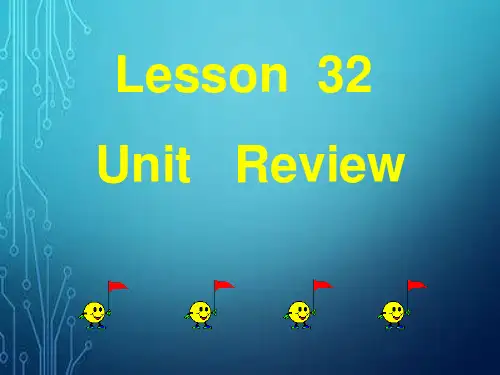
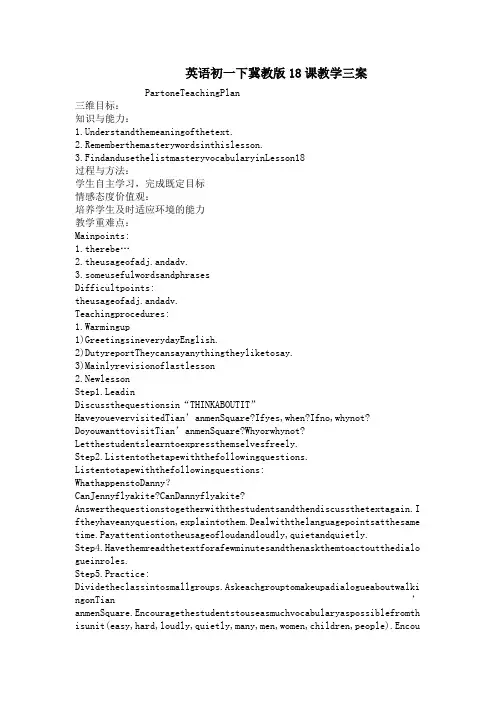
英语初一下冀教版18课教学三案PartoneTeachingPlan三维目标:知识与能力:1.Understandthemeaningofthetext.2.Rememberthemasterywordsinthislesson.3.FindandusethelistmasteryvocabularyinLesson18过程与方法:学生自主学习,完成既定目标情感态度价值观:培养学生及时适应环境的能力教学重难点:Mainpoints:1.therebe…2.theusageofadj.andadv.3.someusefulwordsandphrasesDifficultpoints:theusageofadj.andadv.Teachingprocedures:1.Warmingup1)GreetingsineverydayEnglish.2)DutyreportTheycansayanythingtheyliketosay.3)Mainlyrevisionoflastlesson2.NewlessonStep1.LeadinDiscussthequestionsin“THINKABOUTIT”HaveyouevervisitedTian’anmenSquare?Ifyes,when?Ifno,whynot? DoyouwanttovisitTian’anmenSquare?Whyorwhynot? Letthestudentslearntoexpressthemselvesfreely.Step2.Listentothetapewiththefollowingquestions. Listentotapewiththefollowingquestions:WhathappenstoDanny?CanJennyflyakite?CanDannyflyakite? Answerthequestionstogetherwiththestudentsandthendiscussthetextagain.I ftheyhaveanyquestion,explaintothem.Dealwiththelanguagepointsatthesame time.Payattentiontotheusageofloudandloudly,quietandquietly.Step4.Havethemreadthetextforafewminutesandthenaskthemtoactoutthedialo gueinroles.Step5.Practice:Dividetheclassintosmallgroups.Askeachgrouptomakeupadialogueaboutwalki ngonTian’anmenSquare.Encouragethestudentstouseasmuchvocabularyaspossiblefromth isunit(easy,hard,loudly,quietly,many,men,women,children,people).EncouragethestudentstobeactiveandpraisethemfortalkingriskswithEnglish!Them oretheyexperiment,themoretheylearn.LET’SDOITWorkwithapartner.DrawamapofTian’anmenSquare.Describeyourmapstoeachother.Whatarethepeopledoing?Trytous eloudly,quietly,slowlyandquickly.Step6.ExerciseIftimepermits,doNumber2inworkbook.Homework:1.UnderstandthemeaningofthetextofLesson182.FinishtheworkbookinLesson183.ThenextreadingParttwo学案学习目标:1.Masterywords:laugh,fly,hard,quietly,worry,put2.Learnadialogueaboutflyingakite3.someusefulwords学习重难点:Mainpoints:1.therebe…2.theusageofadj.andadv.3.someusefulwordsandphrasesDifficultpoints:Theusageofadj.andadv.Keypoints:1.therebe…2.theusageofadj.andadv.3.someusefulwordsandphrases课前预习:1. Learnthenewwordsbythemselves,findoutthesentenseswiththenewwords.2. Readthenewtextandtranslateit.新知学习【一】Listenandanswer1.CanJennyflyakite?Yes,shecan.2.CanDannyflyakite?No,hecan’t.3.WhathappenstoDanny?Hehurtshisarm.读课文,判断正误。

初中英语新课程标准教材英语教案( 2019 — 2020学年度第二学期 )学校:年级:任课教师:英语教案 / 初中英语 / 七年级英语教案编订:XX文讯教育机构第十八课 Lesson Eighteen教材简介:本教材主要用途为通过学习英语的内容,提高学生的语言技能,增加一项语言能力,有利于国际化的日常交流、生活、工作等,本教学设计资料适用于初中七年级英语科目, 学习后学生能得到全面的发展和提高。
本内容是按照教材的内容进行的编写,可以放心修改调整或直接进行教学使用。
一、教学内容1.词汇(略)。
2.句型:1) Is Jim picking more apples than Kate? 2) Who has the most apples, Li Lei,Jim or Lily? 3) He's stronger than her.3.语法:数量的比较。
二、教具录音机;约60本作业本。
三、课堂教学设计1.复习值日生报告。
2.请一位同学站在前面,教师交给他(她)10个作业本。
手指这位同学向全班说: T:×× has some exercise books.再请另一位同学站在第一位同学旁边,教师交给他(她)20个作业本。
两位同学都把本拿好,让大家看清区别。
教师说:T:××× has more exercise books than××.反复说两遍,注重重读more一词,启发大家猜测这句话含义(学生应没有多大困难)。
又请第三位同学,与前两位同学站在一起。
教师让该同学拿30个作业本。
教师说: T:××× has the most(exercise books) of all.放慢语速,反复读两遍,启发大家猜测这句话含义。
教师将以上三句话书写在黑板上。
扼要予以讲解。
领读生词,指挥大家学说这几个句子(让全班看着这三位同学说,增加直观性)。
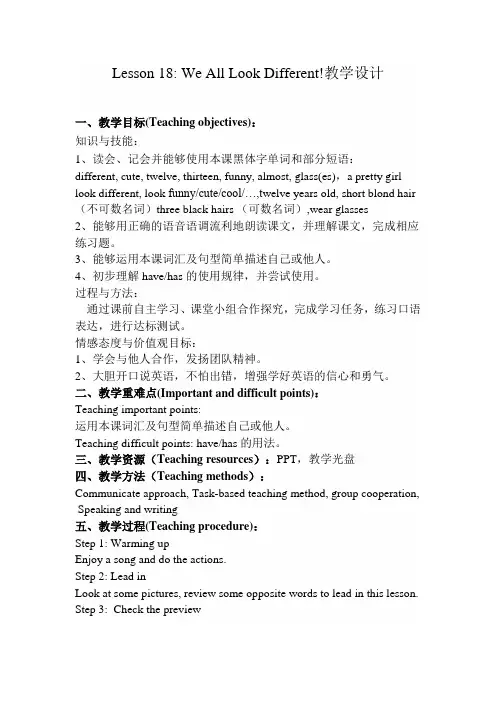
Lesson 18: We All Look Different!教学设计一、教学目标(Teaching objectives):知识与技能:1、读会、记会并能够使用本课黑体字单词和部分短语:different, cute, twelve, thirteen, funny, almost, glass(es),a pretty girl look different, look funny/cute/cool/…,t welve years old, short blond hair (不可数名词)three black hairs (可数名词),wear glasses2、能够用正确的语音语调流利地朗读课文,并理解课文,完成相应练习题。
3、能够运用本课词汇及句型简单描述自己或他人。
4、初步理解have/has的使用规律,并尝试使用。
过程与方法:通过课前自主学习、课堂小组合作探究,完成学习任务,练习口语表达,进行达标测试。
情感态度与价值观目标:1、学会与他人合作,发扬团队精神。
2、大胆开口说英语,不怕出错,增强学好英语的信心和勇气。
二、教学重难点(Important and difficult points):Teaching important points:运用本课词汇及句型简单描述自己或他人。
Teaching difficult points: have/has的用法。
三、教学资源(Teaching resources):PPT,教学光盘四、教学方法(Teaching methods):Communicate approach, Task-based teaching method, group cooperation, Speaking and writing五、教学过程(Teaching procedure):Step 1: Warming upEnjoy a song and do the actions.Step 2: Lead inLook at some pictures, review some opposite words to lead in this lesson. Step 3: Check the preview1. Preview Part 1,look at the pictures and fill in the blanks. Then Look at more pictures and talk about them.What does he/she look like?He/She looks---. He/She is ---.2. Preview Part 2,fill in the blanks and circle the new words in this lesson,then read them aloud ,pay attention to their pronunciation.Step 4:Group cooperation1. Read Part 2 carefully, find out the following phrases, then discuss in groups and translate them into Chinese.1) .look like _________ 2) .look different___________________3).look funny/cu te/cool/…__________________________4).a pretty girl ___________ 5).twelve years old_______________ 5).short blond hair(不可数名词)_______________________7).three black hairs (可数名词)_____________________8).wear glasses______________2. Listen to the tape ,find out the following sentences and underline them. Then read more sent ences and find out how to use “have/has”.She has short blond hair.He has three black hairs.I have short black hair.当主语为第三人称单数时,用_______. 当主语为其他人称时,用________.Step 5. To learn , to use1. Do Ex3 on Page 45,try to use “have/has” to fill in the blanks.2.Look at two pictures, try to describe them by using the words and sentences we have learned today.3. Try to describe yourself and your classmates, your teacher or your parents, if time allows.Step 6. SummaryLet the students sum up the words, phrases, important sentences and gram mar we have learned today.Step 7. Test根据汉语提示完成句子他长得怎么样?_____ _____ he _____ like?2.他看起来很酷。
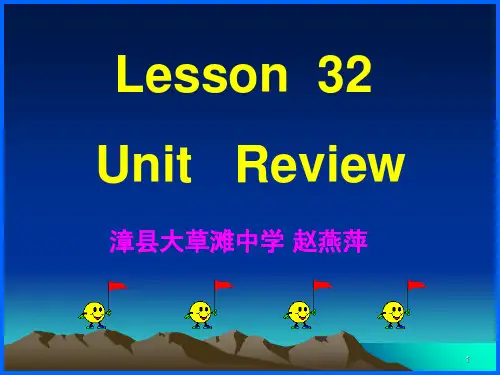
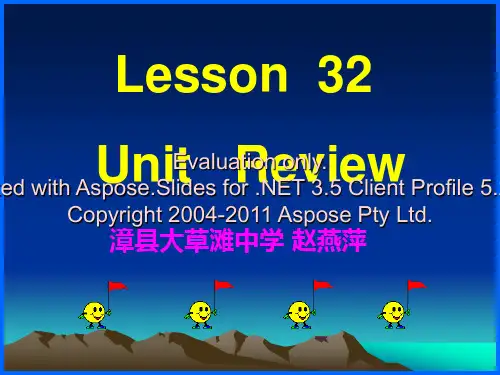
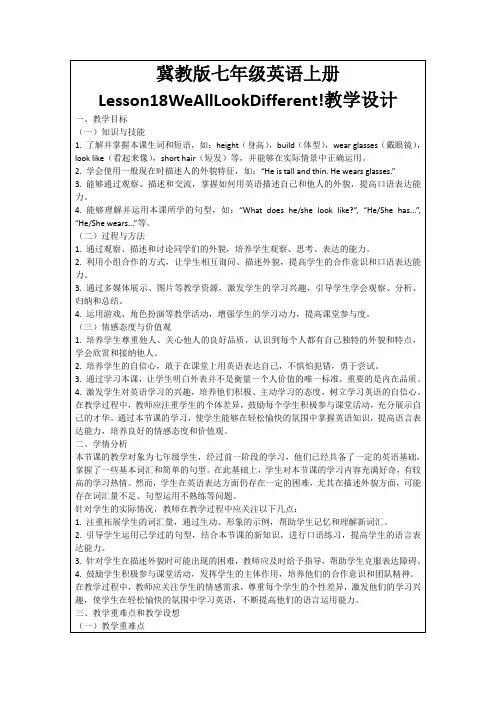
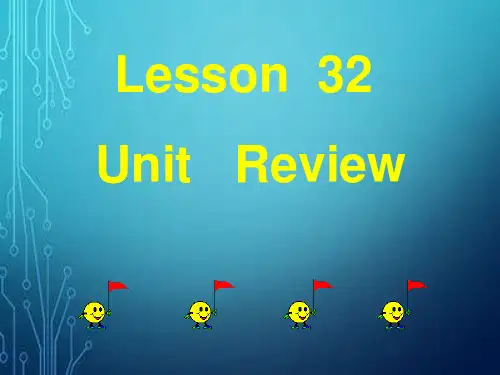
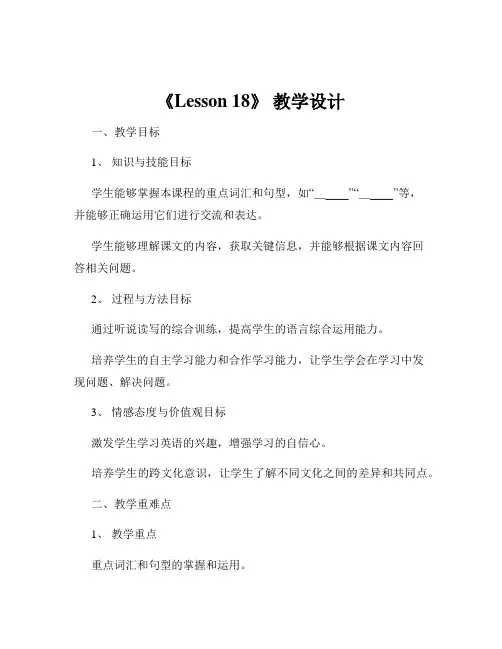
《Lesson 18》教学设计一、教学目标1、知识与技能目标学生能够掌握本课程的重点词汇和句型,如“_____”“_____”等,并能够正确运用它们进行交流和表达。
学生能够理解课文的内容,获取关键信息,并能够根据课文内容回答相关问题。
2、过程与方法目标通过听说读写的综合训练,提高学生的语言综合运用能力。
培养学生的自主学习能力和合作学习能力,让学生学会在学习中发现问题、解决问题。
3、情感态度与价值观目标激发学生学习英语的兴趣,增强学习的自信心。
培养学生的跨文化意识,让学生了解不同文化之间的差异和共同点。
二、教学重难点1、教学重点重点词汇和句型的掌握和运用。
课文内容的理解和关键信息的获取。
2、教学难点如何让学生能够在实际情境中灵活运用所学的词汇和句型。
如何引导学生理解课文中蕴含的文化内涵。
三、教学方法1、任务驱动法布置各种任务,让学生在完成任务的过程中学习和运用知识。
2、情景教学法创设生动的情景,让学生在真实的语境中感受和学习语言。
3、小组合作法组织学生进行小组合作学习,培养学生的合作能力和交流能力。
四、教学过程1、导入(5 分钟)通过播放一段与本节课主题相关的英语视频或展示一些图片,引起学生的兴趣,导入新课。
2、词汇学习(10 分钟)展示本节课的重点词汇,通过图片、例句等方式帮助学生理解词汇的含义和用法。
让学生进行跟读、拼写和造句练习,加强对词汇的记忆和运用。
3、句型学习(10 分钟)呈现重点句型,讲解句型的结构和用法,并结合实际情境进行造句练习。
鼓励学生积极参与,大胆表达。
4、课文学习(15 分钟)让学生听课文录音,初步了解课文内容。
然后,让学生阅读课文,回答一些与课文内容相关的问题,检查学生对课文的理解程度。
5、小组讨论(10 分钟)组织学生进行小组讨论,讨论课文中的一些难点问题或让学生分享自己对课文的理解和感受。
每个小组推选一名代表进行发言。
6、语言运用(10 分钟)创设一些实际的情境,让学生运用所学的词汇和句型进行交流和表达。
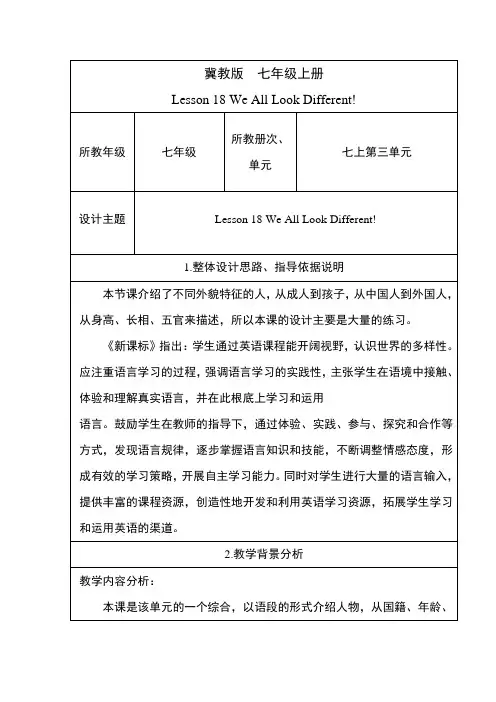
步骤3:Brainstorm:Can you think of some adjectives(形容词) to describe a person?beautiful, good-looking, cool, cute,able, active, alert(机灵的), confident, creative(富有创造力的), cooperative, careful, friendly, hard-working, gentle(有礼貌的), honest, humorous, independent (有主见的), kind, warm-hearted,modest, reliable(可信赖的), selfish(自私的), smart(精明的), strict, easygoing(随和的), pretty, ugly(丑陋的), handsome, good-natured(性格好的), different, funny…设计意图:通过头脑风暴让学生回忆描述人物的形容词,为本课的学习做准备。
步骤4:Learn the new words.通过语篇学习生词。
different [ˈ difrənt] adj. 不同的(反义词same,名词形式difference)be different from------be the same asThey look different.They have different hobbies. They have different hair styles.What makes you different?cute[kju:t] adj. 逗人喜爱的,漂亮的1. The rabbit looks so cute. I really want to tough its fur.第二课时一、教材分析本单元主要是围绕谈论时间和喜爱的学来展开话题,通过本单元的学习,使学生了解时间的表达方法和学的学习方法的相关情况,乐于接触并了解异国文化。
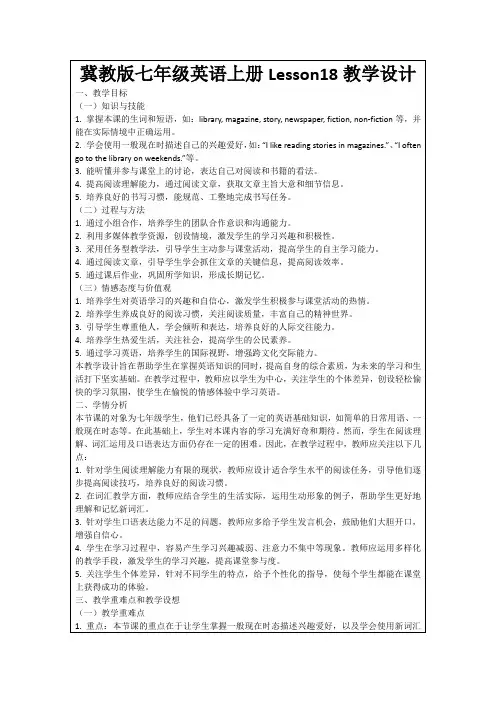
原任初级中学表格式教案(修订)原任初级中学表格式教案(修订)原任初级中学表格式教案(修订)Teacher :What does “hear”mean ?Students : It means to listen with your ears .Teacher :What does “bad news”mean ?2) Teacher :Is the word “happen”a regular or irregular verb ? How do you know ?Students : “Happen” is a regular verb because you just add -ed to end of the word to make it past tense .Teacher : That’s right .The word “lost”is irregular because it does not follow the “add-ed”rule .3) Teacher : Read the title of Lesson 16 and look at the first picture .Can you guess what happens in this lesson ? Help the students answer this question .Students : Does something terrible happen ?Look at the first picture and discuss .Step 3 ReadPair Work : Let Do It !No.11)Instruct the students to read Lesson 16 silently ,and think about the questions on their own .2)Ask the students to work in pairs and ask and answer the questions.3)Check the answers as a class .原任初级中学表格式教案(修订)Step 4 Listen and Read1)Listen to the tape once and ask the students just to listen.2)Listen to the tape again and ask the students read aloud .3)Remind the students to do their best to imitate the pronunciation they hear .Step 5 :TaskGroup Work : Let’s Do It ! NO.41)Split the class into groups to discuss Let’s Do It ! No.4 and brainstorm some answers to the questions .2)Each group should define what the problem to the problem . You may want to use the sample plan below as a guide .Step 6: Language Notes1) I’m doing well我很好。
第十八课 Lesson Eighteen_七年级英语教案第十八课Lesson Eighteen一、教学内容1.词汇(略)。
2.句型:1) Is Jim picking more apples than Kate? 2) Who has the most apples, Li Lei,Jim or Lily?3) He’s stronger than her.3.语法:数量的比较。
二、教具录音机;约60本作业本。
三、课堂教学设计1.复习值日生报告。
2.请一位同学站在前面,教师交给他(她)10个作业本。
手指这位同学向全班说:T:×× has some exercise books.再请另一位同学站在第一位同学旁边,教师交给他(她)20个作业本。
两位同学都把本拿好,让大家看清区别。
教师说:T:××× has more exercise books than××.反复说两遍,注重重读more一词,启发大家猜测这句话含义(学生应没有多大困难)。
又请第三位同学,与前两位同学站在一起。
教师让该同学拿30个作业本。
教师说:T:××× has the most(exercise books) of all.放慢语速,反复读两遍,启发大家猜测这句话含义。
教师将以上三句话书写在黑板上。
扼要予以讲解。
领读生词,指挥大家学说这几个句子(让全班看着这三位同学说,增加直观性)。
反复练习说几遍,到学生能初步掌握为止。
教师手指这三位同学,继续提问:T:Who has the most exercise books, ××,××× or ××?And who has the fewest?学生应当能较容易地正确答出。
3.打开课本,学生看图。
放课文第1部分录音,学生跟读,反复三遍。
教师直接用课文第3部分问题向学生提问,要求学生给出正确答案。
4.指导学生看课文第2部分插图,教师可作如下提问,要学生做出正确应答:T:Who is picking more apples, Jim or Kate?Which truck is carrying more ladders, the big one or the small one?学生给出简略答语即可。
教strong这个生词。
放课文第2部分录音,学生跟读,反复三遍。
5.指导学生做练习册习题。
6.布置作业1)练习朗读课文;2)抄写生词、课文第1、3两部分内容;3)完成练习册习题。
四、难点讲解1.He’s stronger than her.他比她健壮。
be+形容词(比较级形式)+than是比较级的基本句型。
than是连词,其后面既可用宾格代词her,也可用主格代词she。
2.Who has the most apples, Li Lei, Jim or Lily?谁的苹果最多,是李磊、吉姆还是莉莉?三者或三者以上比较要用最高级。
由于是在三者之间比较,连词用or(或者),而不能用and (和)。
第六十二课Lesson Sixty-two一、教学内容复习can的用法、表示位置(空间)的介词短语及句型、物主代词和有关句型以及时刻表示法。
二、教具教具钟等。
三、课堂教学设计1.值日生报告。
2.打开书,指导学生看图,两人一组用课本提供的问题进行问答练习,并要求学生用笔头形式将答案写出。
请几位同学朗读自己的答案。
3.学生两人一组,就课文第二部分的插图进行问答练习。
教师可先与一位同学做示范。
小组练习后,请几组同学给出自己的答案。
4.指导学生做练习册习题。
要求学生用笔头形式答出。
5.布置作业完成练习册习题。
Unit 3 Mid-Autumn Day一、教学目标与要求通过本单元教学,使学生初步掌握形容词比较级和最高级的基本构成和一些基本用法,并能口、笔头运用。
能独立完成练习册有关内容的习题,正确率不低于70%,并能就一些简单物体,如盒子、尺子等,进行大、小、长、短等比较。
学生应能正确读出[e] [$][000)]三个音标,掌握本单元所列出对应这三个元音的字母及字母组合的读音和拼写形式;在朗读词组和句子中,正确使用重音和语调。
二、教学重点与难点1.句型;1) I’d like you to meet…2) Han Meimei’s cake is bigger than Lily’s 3) Jim’s cake is the biggest of all.2.语法:形容词比较级、最高级(1)。
3.日常交际用语:学习表示邀请和应答的用语。
三、课时安排本单元共用4课时,每课书用1课时。
Activity 11. Lead-in: (Slide 1—6 )(1) Revise kinds of transportation using pictures on TV:--bike / motorbike / bus / train / taxi / subway / plane / car / jeep / ship--walk ( on foot )(2) Revise the sentences below by asking and answering with Ss:--How do you get to school?--How does he / she get to school?--How do they get to school?( Ask the Ss who ride their bikes to schoolto put up their hands. )2. Present the pictures of Jili Middle School and my home, then say: (Slide7)I usually take a taxi to school.It takes about / around 15 minutes.3. Next, lead to the model:A: How do you get to school?B: I take a taxi to school.A: How long does it take?B: It takes about / around 15 minutes.And then read and practice after the teacher.4. Explain ‘minute’and ‘around’using simplified clocks on the Bb.5. Write down the conversation below when the teacher is making a survey:T: How do you get to school?S: I take the bus / walk /…to school.T: How long does it take?S: It takes about / around 5/15/…minutes.6. Groupwork.7. Act out.Activity 2 ( Listening )1.( Section A, 2a ) Lead the Ss to go through the kinds of transportationand listen, then check some of them that they hear.2. Check with the Ss.3. ( Section A 2b ) Listen again and match the time with the kinds of transp-ortation in 2a.4. Practice and check.Activity 31. Remind the Ss to be on time for school.2. Lead the Ss to have a look at the children in the countryside, then elicit theanswer to the question from Ss: (Slide 8 )How do they get to school?3. ( Slide 9—10 )Play a guessing game, and then ask the Ss to discuss the two singers ( Zhou Jielun and Cai Yilin ) with their partners and talk abouttheir opinions.HomeworkMake a survey according to the chart below:Who How How long Where… … … … … … … …Writing on the Bb:Revision New items:1.How do you get to school? A: How do you get to school?I ride my bike. B: I ride my bike / take the …2. How does he / she get to A: How long does it take?school? B: It takes 15 / 20 /… minutes.3. How do they get to school?They ride their bikes.。